 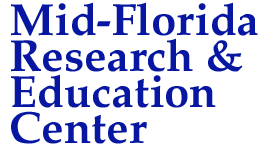 |
  |
| The
Pink Hibiscus Mealybug
MANAGEMENT An adult mealybug destroyer, Cryptolaemus montrouzieri Mulsant on a hibiscus flower cleaning itself. This insect and its larvae feed on all stages of mealybugs and can be found when mealybug populations are high enough to support reproduction.VIDEO LINKYouTube |
| RETURN
TO PINK HIBISCUS MEALYBUG PAGE RETURN TO THE MAIN MREC-MEALYBUG PAGE TO COMPARE PHOTOS OF COMMON MEALYBUGS |
|
|
|
The Pink Hibiscus Mealybug or PHM is a pest that has devastated agriculture in many parts of the world. If left uncontrolled, it will kill plants and even trees. Our management options include the use of chemical and biological controls. Biological control offers the safest, most economical and long term solution to this problem. This strategy relies on producing sufficient numbers of tiny wasps (parasitoids) that attack and kill the PHM. These wasps lay their eggs inside individual mealybugs. When the eggs hatch the immature stage of the "parasitoid" feeds on the mealybug from the inside. After 2-3 weeks, an adult wasp will emerge, find a mate and then start to lay her eggs in many more mealybugs. These wasps DO NOT ATTACK plants, other animals or people. In fact, they don't even attack other mealybugs. They are so small most people will never see them. The problem with this system is that it takes time for the natural enemies to build up sufficient numbers to reduce the mealybug population to a tolerable level. USDA-APHIS and the Florida Department of Agriculture, Division of Plant Industry (DPI) have a limited supply of parasitoids to release. In order to prevent significant losses of plant material and allow for more efficient establishment of the natural enemies, we feel that the homeowner could use a couple tactics. Most pesticides sold in retail garden centers will kill any natural enemies that come in contact with the treated plants. This effect can last for months. The mealybugs are much less sensitive and will begin to build up damaging populations soon after application. THE HOMEOWNER MUST CHOOSE THE CORRECT PESTICIDE OR THEY WILL MAKE THEIR MEALYBUG PROBLEM WORSE. If they choose one of the insecticidal soaps or oils available through their local garden center, they should apply it once prior to the release of natural enemies. Care should be taken to apply the soap or oil or combination of soap and oil to only one plant and observe the plant for damage. Damage will be noticeable within 2 to 3 days. Another pesticide option is available to the homeowner. One product on the market is called Bayer Advanced Tree & Shrub Insecticide. The active ingredient is used to manage mealybugs in nurseries. This material should be mixed and applied exactly as described on the label; to the soil. DO NOT TREAT ALL OF YOUR INFESTED PLANTS! At least one infested plant should be untreated so that wasps can be released on it. The wasps will establish on this plant which will then serve as a source for control agents that will search your property for other mealybugs. Another option would be to physically remove most of the infested plant material. DISPOSAL FOR INFESTED PLANT MATERIAL SHOULD FOLLOW USDA-APHIS AND DPI GUIDELINES! Natural enemies will then be released into the remaining population and serve as a source for control agents that will search your property for other mealybugs.
YOUR UNIVERSITY OF FLORIDA COUNTY EXTENSION PERSONNEL CAN HELP! PLEASE CONTACT THEM FOR ADDITIONAL GUIDANCE
|
|
|
|
Scouting is absolutely essential in the management of mealybugs. When
scouting for this pest, it is advisable to also check the root systems.
There are reports that PHM will also feed on parts of the plant below
the soil line. Although the toxin of PHM can result in much more damage
than most mealybug pests, it does aid in finding low or incipient
populations whereas other species may not be detected until very dense
populations have developed. It is wise to quarantine newly acquired
plants and, if careful examination shows living mealybugs are present,
apply effective insecticides until the infestation is eliminated.
Treatments should also be made to the area in which the infested plants
were maintained. The crawler stage of mealybugs is the most fragile
stage and the most susceptible to chemical control. Under the best of
circumstances, chemical control is difficult because the waxy covering
protects the mealybugs and eggs from chemical exposure. Sprays should be repeated at two to three week intervals. Persistence in treatment
and careful observation of results will be required to bring success.
Continue to check for living insects on the foliage, stems, and on the
pots and bench. Adult female mealybugs will crawl off plants and
can be found on bricks, under benches and ground covers where they lay
eggs.
Once mealybug pests become established, it is extremely difficult to achieve acceptable control. Many growers find it more economical to cull any obviously infested plants prior to applying pesticides. However, just dumping infested plants is not enough; the entire growing area should be sanitized. In recent years chemical control has become very difficult. We have relied on systemic insecticides because spray coverage is extremely difficult due to the clumping nature of mealybugs. However, many of these materials are no longer commercially available. Secondly, bendiocarb (Ficam, Turcam, Dycarb, Closure) one of our most effective spray materials, may not be on the market much longer either. Studies have shown that the addition of nonionic spreaders can increase the efficacy of some materials. There are many excellent materials being sold for this purpose. Before one uses a surfactant of any kind, the label and the manufacturer should be consulted for guidance. Some labels actually state that adjuvants (i.e., spreaders) should not be added to the spray mix. Organosilicone surfactants are a new "class" of wetting agents. They are extremely active at very low concentrations. Some companies, however, are hesitant to recommend the addition of organosilicone surfactants to their insecticides because of the potential of increased phytotoxicity due to increased penetration of the pesticide into the plant tissue. Because of the lack of research the best that can be offered is our best guest. First, destroy as much of the infested material as you can. Next, drench the remaining plants with either thiamethoxam (Flagship 25 WG), dinotefuran (Safari 20SG) or a material containing imidacloprid, which in the case of a commercial nursery would be Marathon 60WP or Marathon II. Soil drenches have been more effective for whiteflies than foliar sprays. Foliar sprays of Talus and Tristar have also shown very good efficacy when applied to other species of mealybugs. In a recent study at MREC, we were able to manage a heavy population of Phenacoccus madeiresis Green attacking hibiscus with a soil drench. In another study, we were able to prevent the establishment of PHM on hibiscus treated with a soil drench of either Flagship 25 WG, Marathon II or Safari 20SG when these materials were applied at the maximum labeled rates. Two days after treatment, all treated plants were exposed to a heavily infested plant. Mealybugs fed on the treated plants and damage was noted but one month post-treatment, none of the treated plants were infested and the control plants were heavily infested and damaged. Plants treated with a drench of these systemic insecticides should be sprayed as soon as possible after the drench application with a tank mix of Orthene and a synthetic pyrethroid (i.e., Talstar, Tame or Decathlon). This s pray application is to kill those mealybugs that are not feeding on the plants, which is a common occurrence for a certain portion of the reproductive females. Tank mixes of two or more products are generally not advised. However, some combinations have been shown to increase the level of control not obtained when compared to application of any of the materials separately. For example, the combination of bifenthrin and acephate greatly increased our ability to manage the silverleaf whitefly. Bayer produces a retail product which combines imidacloprid and cyfluthrin. This may be a combination that could prove useful for managing mealybugs especially if a nonionic spreader is added to the SPRAY mix. Phytotoxicity tests are highly recommended! Seven days after this treatment I would treat again with another compound registered for mealybug control. Foliar sprays of buprofezin (Talus 40 SC) and acetamiprid (Tristar 70 WP) have also shown very good efficacy when applied to other species of mealybugs. A search of C & P Press reveled over 75 insecticides labeled for mealybug control on ornamentals outdoors and 40 for ornamentals grown in the greenhouse. The University of Florida EDIS Website (Commercial Foliage and Woody Ornamental Arthropod Pest Management at http://edis.ifas.ufl.edu/IG012) lists some but not all of the materials registered for mealybug control.
Studies at the University of Hawaii (Hara, personal communication) have shown that chlorpyrifos and Talus are very effective at controlling this pest. Dimethoate has been a reliable systemic product of managing mealybugs and scales on many ornamental plants. At this point, we have seen no data to indicate how effective it would be on PHM nor as to how safe it would be on the plants that are infested with this pest. Distance is a insect growth regulator that has activity against mealybugs, has a long residual activity and penetrates the leaf killing insects on both sides (translaminar). If your nursery is free of mealybugs you don’t have to be as aggressive but if you are in an infested area a program similar to this would be highly advisable. Studies are currently underway comparing Flagship, Marathon, Tristar and a few other materials for mealybug control. Marathon drenches have activity for more than a month whereas the spray last only a couple of weeks. Additional applications of Marathon can be made but there are restrictions on the some labels as to how often a crop can be treated. The second application should probably be reserved for the unfortunate circumstance of the plants becoming infested otherwise you will not be able to legally meet there requirements of a compliance agreement. Scouting with frequent and alternating applications on the compounds listed in the Commercial Foliage and Woody Ornamental Arthropod Pest Management Guide should significantly reduce the chances of the mealybug becoming established. The frequency will depend on economics, plant safety and logistics. Which compounds to alternate between depends on the mode of action each compounds possesses. A good site that contains a list of this type of information is at: http://www.olympichort.com/ go to Online Resources at the top and then click on the Chemical Class Chart at the bottom of the page. Biological control has been suggested as a potential control tactic for many mealybugs that attack ornamental plants but availability of quality predators and parasitoids for use is limited. Additionally, successful control obtained with natural enemies has been erratic. At this point in time, commercial growers should not consider biological control for the management of the PHM in production areas. Growers should be very aggressive with preventative and curative actions which includes the use of pesticides. Table 1 lists materials that can be used for PHM control. Because this pest has just entered Florida, no research has been conducted to determine the most effective methods for controlling it in commercial settings. The table should be used with that in mind!! Biological control of this pest will play a major role in areas around the nursery that cannot or will not be treated with pesticides. These areas could include urban neighbors, public lands, and areas that could produce mealybug populations that could infest commercial areas. The biological control agents that have shown the most promise in the Caribbean are the predatory ladybird beetle or ladybug called the mealybug destroyer, Cryptolaemus montrouzieri. This predator can often be found on cycads infested with the longtail mealybug and can be purchased from a number of commercial sources. This beetle will feed on all stages of the mealybug. Cryptolaemus larvae are often confused for large mealybugs because they are covered with a white secretion which allows them to hide from other mealybug predators or ants that tend mealybugs. Anagyrus kamali, is the most important natural enemy currently used to manage PHM. A. kamali is a small parasitic wasp that feeds almost exclusively on the PHM. Parasitic wasps that attack mealybugs kill their hosts in two ways. The adult wasp will puncture a mealybug with its ovipositor (an appendage on the rear of the female which is used to lay eggs in a host). As fluids exude from the wound of the dying mealybug, the female wasp will feed on the fluid. This material is a source of nutrients that will be used to help mature the wasp’s eggs. The wasp can also kill by parasitizing an appropriately aged mealybug. The female will find a mealybug, determine if it is a suitable host and then lay an egg inside of it. The egg will hatch within the mealybug and the larva will feed internally, killing the mealybug. The larval stage of the wasp will pupate inside the dead mealybug. Once this occurs the outward appearance changes. If the remaining waxy material is brushed away, the parasitized mealybug now looks like a brown, shiny grain of rice. When the fully developed adult wasp emerges from what is now called a mummy, it cuts a circular hole in the end of the mummy and crawls out. The complete process can take place in about half the time it takes for the entire life cycle of the mealybug. USDA-APHIS cautions us about the use of the predatory beetle during the initial phases of getting the parasitoid established in a new area as follows:
We have also been warned that pruning or spraying infested plants with an insecticide can also have a negative impact on establishment and control. Another issue that must be taken into account when trying to establish natural enemies of any honeydew-producing host is ants. Ants tend these insects for their honeydew and they can be extremely disruptive in biological control programs. In California citrus groves, ants must be managed before biological control can be effective. |
||
| Two parasitoids are being released into
Florida for the management of this mealybug. TOTALS AS OF July 16, 2004 Anagyrus kamali 414,800 Gyranusoidea indica 542,400 There have been approximately 2,962 releases at 1132 sites. At this point in time all we can say is that the parasitoids appear to have become established in many areas where the mealybug is found. Infestations run the gamut from nothing to severe. The percent parasitization at 8 USDA study sites in South Florida ranged for 6.0 to 100% with an average of 32.5%. The percent hyperparasitism (parasitoids killing the released parasitoids), at sites that had mealybugs to be parasitized, ranged between 10.4 and 51.3%. The number of mealybugs at a number of the study sites was zero, very low at others with only one being relatively high. (Data from: BIOLOGICAL CONTROL OF PINK HIBISCUS MEALYBUG IN SOUTH FLORIDA: A One-year Assessment. Divina M. Amalin, Kenneth A. Bloem, Dale Meyerdirik, and Ru Nguyen. October 2003)
–
|
| Anagyrus kamali
females |
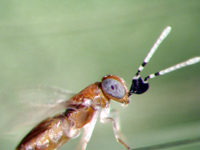
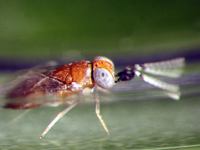
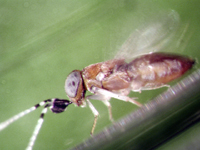 |
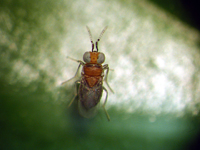
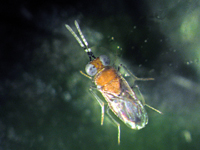 |
| male |
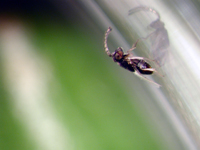 |
|
In
order to view a video of Anagyrus kamali please click
here!
( In this clip, the female is seen first and the darker less colorful male is seen at the end.) |
| The Mealybug Destroyer |
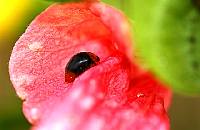 |
An adult mealybug destroyer, Cryptolaemus montrouzieri Mulsant on a hibiscus flower cleaning itself. This insect and its larvae feed on all stages of mealybugs and can be found when mealybug populations are high enough to support reproduction. VIDEO LINKYouTube
|
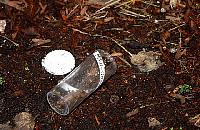 |
This plastic vial contained adult Gyranusoidea indica that were release by USDA and DPI for the control of PHM. Gyranusoidea indica is a small parasitic wasp that feeds and kills mealybugs. The wasp is very tiny (smaller than the adult mealybug) and does not attack plants, animals or people. IN ORDER TO ALLOW THESE NATURAL ENEMIES TO BECOME ESTABLISHED PLEASE DO NOT APPLY PESTICIDES! CONTACT YOU LOCAL COUNTY EXTENSION AGENTS FOR GUIDANCE. TO FIND THE PHONE NUMBERS OF YOUR EXTENSION OFFICE OR YOU LOCAL PLANT INSPECTORS CLICK ON THE FOLLOWING: UNIVERSITY OF FLORIDA EXTENSION: http://www.ifas.ufl.edu/extension/index.htm FLORIDA DIVISION OF PLANT INDUSTRY: 1-352-372-3505 PINK HIBISCUS HOT LINE: 1-888-397-1517 |
| All photos are the property of Lance S. Osborne ( lsosborn@ufl.edu ) and the University of Florida. Please ask permission before using! I would appreciate any comments concerning the content of this page (errors, omissions....). |